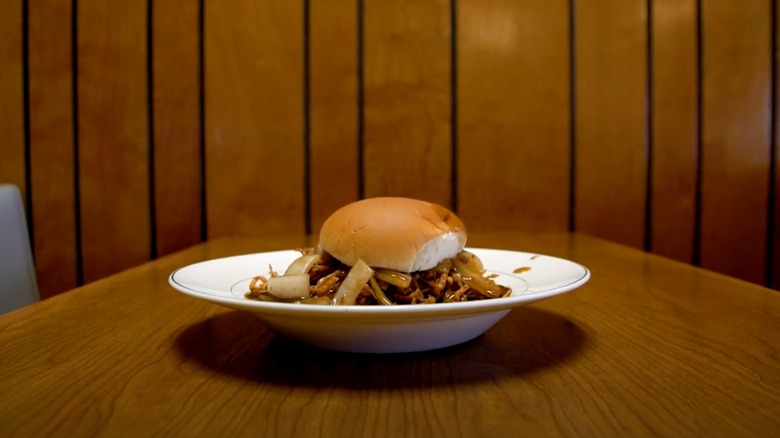The Innovative Inspiration That Led To Massachusetts' Unique Chow Mein Sandwich
Chow mein? Yum. Gravy? Good. Soft buns? Also, delicious. All those things combined? Sounds interesting, to say the least. In the small town of Fall River, Massachusetts, this fusion of Chinese and American classics has been a favorite for over 100 years. The chow mein sandwich combines crispy chow mein noodles cooked with vegetables and chopped meat, smothered in brown gravy, and served hot on a soft hamburger bun.
The sandwich is rooted in the industrialization of America and the influx of Chinese immigrants to the East Coast following the completion of the transcontinental railroad and rising immigration tension in the West. Textile factories littered New England, and Fall River was no exception. In the early 1900s, Fall River's population was comprised largely of European immigrants who worked in the many textile factories. As Chinese immigrants transitioned from laundromats and tea shops to restaurants, the chow mein sandwich was born as a way to introduce other ethnicities to Chinese cuisine in a way that would feel familiar to them: a sandwich. There are no language barriers when it comes to great food, and the addition of the hamburger bun on an already iconic dish made it more welcoming to those used to a Western diet. Plus, a handheld sandwich is easy (and quick) for a worker to eat on a short break or after a long shift.
Sauced in History
The classic construction of this dish features minced meat folded into crispy egg noodles with cooked vegetables, but modern iterations mainly feature pork as the protein of choice. Other variations can replace the pork for chicken or shrimp — or even subtract the meat altogether. Massachusettsans call removing the meat or the veggies from the dish a strained sandwich. The use of crispy chow mein versus soft low mein adds needed texture to a very loose sandwich with the amount of thick gravy involved, akin to a sloppy joe sandwich.
The chow mein sandwich isn't just a staple in northeastern food culture but a hallmark in cultural and culinary anthropology. So much so that Ivy League professors have written dissertations on the commingling of cuisines using the chow mein sandwich as their prime example.
Chinese fusion cuisine isn't exclusive to the United States. Nestled in Baja California, Mexico restaurants have been combining their native Mexican dishes with Chinese food under similar circumstances. Following the Chinese Exclusion Act of 1882, would-be U.S. immigrants landed in Mexico, leading to an influx of interesting spins on tamales and other classic Mexican dishes. Next time you bite into the gravy-soaked goodness that is the chow mein sandwich, know you're taking a bite of history made possible by those who have immigrated to the States.


